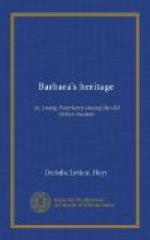Murmured exclamations attested the interest with which the comparison was made. After all seemed satisfied, Mr. Sumner continued:—
“After Raphael came to Rome, summoned by the same Pope Julius II. who sent for Michael Angelo, and was thus brought under the influence of that great painter, his method again changed. It grew firmer and stronger. Then he painted his best pictures,—and so many of them! So, you can see, it is somewhat difficult to characterize Raphael’s work as a whole, for into it came so many influences. One thing, however, is true. From all those whom he followed, he gathered only the best qualities. His work deservedly holds its prominent place in the world’s estimation;—so high and sweet and pure are its motifs, while their rendering is in the very best manner of the High Renaissance. No other artist ever painted so many noble pictures in so few years of time.”
“Did not his pupils assist him in many works, uncle?” asked Malcom, as his uncle paused for a moment.
“Yes,” replied Mr. Sumner, rising, “especially in the frescoes that we shall see by and by. It would have been utterly impossible for him to have executed all these with his own hand. Let us now go out into this next gallery through which we entered, and look at the Transfiguration.”
So they went into the small room which is dedicated wholly to three large pictures:—the Transfiguration and Madonna di Foligno by Raphael, and the Communion of St. Jerome by Domenichino.
“Raphael’s last picture, which he left unfinished!” murmured Bettina, and she took an almost reverential attitude before it.
“How very, very different from the Coronation!” exclaimed Barbara, after some moments of earnest study. “That is so utterly simple, so quiet! This is more than dramatic!”
“Raphael’s whole lifetime of painting lies between the two,” replied Mr. Sumner, who had been intently watching her face as he stood beside her.
“Do you like this, Mr. Sumner? I do not think I do, really,” said Miss Sherman, as she dropped into a chair, her eyes denoting a veiled displeasure, which was also apparent in the tones of her voice.
“It is a difficult picture to judge,” replied Mr. Sumner, slowly. “I wish you all could have studied many others before studying this one. But, indeed, you are so familiar with Raphael’s pictures that you need only to recall them to mind. This was painted under peculiar circumstances,—in competition, you remember, with Sebastian del Piombo’s Resurrection of Lazarus; and Sebastian was a pupil of Michael Angelo. Some writers have affirmed that that master aided his pupil in the drawing of the chief figures in his picture. Raphael tried harder than he ever had done before to put some of the dramatic vigor and action of Michael Angelo into the figures here in the lower part of the Transfiguration. The result is that he overdid it. It is not Raphaelesque; it is an unfortunate composite. The composition is fine; the quiet glory of heaven in the upper part,—the turbulence of earth in the lower, are well expressed; but the perfection of artistic effect is wanting. It is full of beauties, yet it is not beautiful. It has many defects, yet only a great master could have designed and painted it.”




